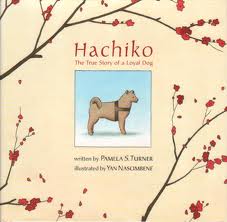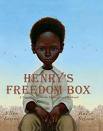Posts tagged ‘narrative nonfiction’
147. Hachiko: The True Story of a Loyal Dog by Pamela S. Turner
 Retell: Everyday Hachiko accompanies his owner, Dr. Ueno to Shibuya Station and patiently awaits his return. When Dr. Ueno doesn’t return one day Hachiko continues to wait at the station…for ten years.
Retell: Everyday Hachiko accompanies his owner, Dr. Ueno to Shibuya Station and patiently awaits his return. When Dr. Ueno doesn’t return one day Hachiko continues to wait at the station…for ten years.
Topics: dogs, Japan, loss, loyalty, Tokyo
Units of Study: Nonfiction, Memoir
Tribes: mutual respect, appreciations/no put downs
Habits of Mind: persistence
Writing Skills: using imagery, describing setting details
My Thoughts: A colleague of mine gave me this book as a gift knowing my connection with Japan. I taught in Japan for three years. Last summer when I visited Japan again I took a trip to Shibuya Station and learned about the story of Hachiko.
I’m not sure if I’d be able to read this book out loud to my class without crying, or making someone else cry. It’s such a beautiful book though. I can see using this as a mentor text for showing how writers describe the setting. Many of my students have difficulty describing anything but the weather. This text shows how a writer takes time to describe the ‘action’ of the setting–the movement of the crowd, the clothes the people are wearing, etc.
143. Diary of a Worm by Doreen Cronin
 Retell: Through a worm’s diary the reader learns about the ups and downs of being an earthworm.
Retell: Through a worm’s diary the reader learns about the ups and downs of being an earthworm.
Topics: earthworms, diaries, composting, differences, predators, soil
Units of Study: Content Area, Nonfiction
Habits of Mind: Finding Humor
Reading Skills: monitoring for sense, synthesis
My Thoughts: My class has just started a study on earthworms. Before read aloud each day we check on our worms working hard in our new worm compost bin. Students are bringing food scraps from their lunches (one student even brought coffee grounds from home). A colleague of mine referred me to this adorable book that allows readers to look at the world through the humorous perspective of a young earthworm. I think this book will make an excellent mentor text for students who are deciding to write narrative nonfiction pieces. It’s a great text for teaching readers to be on the look out for jokes and for teaching writers how to incorporate humor into their writing.
113. They Came from the Bronx: How the Buffalo Were Saved from Extinction by Neil Waldman
 Retell: Told from two perspectives, this book describes how the American Bison Society reintroduced a small herd of bison.
Retell: Told from two perspectives, this book describes how the American Bison Society reintroduced a small herd of bison.
Topics: buffalo, Bronx Zoo, conservation, Native Americans, Comanche Indians, westward expansion, wildlife introduction
Units of Study: Nonfiction, Content-Area
Tribes: mutual respect
Habits of Mind: thinking flexibly
Reading Skills: envisionment, monitoring for sense
My Thoughts: This book combines narrative and non-narrative text. The book begins with a Comanche woman telling her grandson about the days when buffalo roamed the land. On the next page the author describes how 2,000 miles a way trains with mysterious creatures leave the gates of the Bronx Zoo. While reading this book it would be great to have a map of the United States displayed so students could see the route the buffalo traveled.
37. Tallchief: America’s Prima Ballerina by Maria Tallchief with Rosemary Wells
 Retell: This is an autobiographical story of Maria Tallchief, one of the greatest American-born ballerinas of her time.
Retell: This is an autobiographical story of Maria Tallchief, one of the greatest American-born ballerinas of her time.
Topics: native americans, Osage, Oklahoma, ballet, Westward Expansion, music, interests, biographies, narrative nonfiction
Units of Study: Social Issues, Nonfiction
Tribes: personal best
Reading Skills: inference, determining importance, envisionment
Writing Skills: seeing the world as a writer, using interesting transitional phrases
My Thoughts: This story is great to read when discussing what it means to put your all into something. Maria Tallchief lived, breathed, and ate music and dance. She writes about how her teacher told her to live like a dancer “When you sleep, you must sleep like a dancer. When you stand and wait for the bus, you must wait for the bus like a dancer.” This particular scene reminds me how we often challenge our students to live like writers. Perhaps now we can tell students, “When you wait for the bus, you must wait for the bus like a writer–notebook in hand, waiting to collect stories.”
15. Henry’s Freedom Box by Ellen Levine
 Retell: This is the true story of Henry “Box” Brown. After his family was sold to another plantation, Henry decides to escape to freedom via the postal service.
Retell: This is the true story of Henry “Box” Brown. After his family was sold to another plantation, Henry decides to escape to freedom via the postal service.
Topics: underground railroad, slavery, perseverance
Units of Study: Nonfiction, Content-Area Reading and Writing, Historical Fiction
Tribes: personal best
Reading Skills: inference, emapthy
Writing Skills: incorporating symbolism, using setting details
My thoughts: I can see why this won a Caldecott Award. The illustrations by Kadir Nelson are larger than life. What’s nice about this book, as well as many biographies written for young readers, is its author’s note. Reading both the story and the author’s note is a nice way to compare narrative and expository nonfiction. Though Henry’s Freedom Box is a biography, I could also see reading this book during a unit on historical fiction to examine how an author tucks in historical details.
13. A Dandelion’s Life by John Himmelman (The Nature Upclose Series)
 Retell: John Himmelman tells the life story, from seed to bloom, of the unappreciated dandelion.
Retell: John Himmelman tells the life story, from seed to bloom, of the unappreciated dandelion.
Topics: dandelions, flowers, life cycle, narrative nonfiction
Units of Study: Nonfiction, Content-Area Reading and Writing
Reading Skills: prediction, determining importance, monitoring for sense
Writing Skills: incorporating transitional phrases, including text features
My Thoughts: A Dandelion’s Life is but one of several narrative nonfiction books in the Nature Upclose Series. After reading this book I had a new appreciation for the dandelion. This is a decent, simple example of narrative nonfiction that could be used as a mentor text during the Content-Area Reading and Writing unit. If you’re a fourth grade teacher in New York, you will be pleased with how well this book could align with the Science unit: Food Chains and Life Cycles. Our fourth grade team is considering aligning that Science unit with the Content-Area Reading and Writing units, making A Dandelion’s Life a perfect read aloud fit. The illustrations don’t just exclusively feature the dandelion. Throughout the narrative butterflies, snakes, fireflies, birds and crickets make appearances. I can envision readers using the illustrations to envision the habitat of each creature. I think I’m going to keep my eye out for more books in this series.